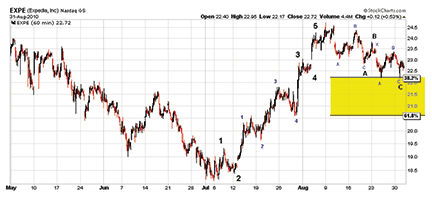MONEY MANAGEMENT
Closing Your Positions
Manage Your Trades With Elliott Wave
When should you take a position, where should you take a gain, and when should you call it quits? Here’s how you can identify entry, stop, and target levels for your trades.
The easy part of investing in stocks is getting into a trade. You study the chart, understand the company’s business and fundamentals, find your buy point, and then dive in with big expectations. But what’s next? How do you know when to take your gains off the table, or more important, when to tuck your tail and run when it goes against you?
Should and shouldn’t
Many traders know that you must protect your investment with a stop level, because no matter how much sweat and tears you put into your research, there will be plenty of times when it doesn’t matter and the stock goes the other way. The answer for many has been to use a trailing stop — say, 5% below their entry point. This seems like a rational conclusion because it defines your risk at a reasonable level. But who’s to say that the stock didn’t cue up a 5% pullback, just to reload for the next upleg?
Using an arbitrary target and stop level will get you arbitrary results. Hopefully, it works out in your favor, but if it doesn’t, you won’t know why or what the stock is telling us.
There’s a better way. You have to have a full understanding of your expectations from a stock move, based on what should and shouldn’t happen if the pattern being traded is the pattern you think it is.
No theory can provide you these answers as succinctly as the Elliott wave theory. When used in conjunction with Fibonacci retracement and extension levels, you have a wealth of knowledge about what a stock chart is telling us, when the time is right to take a position, where to take a gain, and when to call it quits because the pattern you thought was playing out is not.
The purpose of this article is to demonstrate how you can access this information so that there are good reasons for closing gains and taking losses at specific points. Let’s run through an actual trade to detail the process.

Figure 1: trending impulse followed by a correction. In August 2010, price action on EXPE told us that further upside strength was coming, courtesy of an impulse up followed by a corrective pullback that retraced 38.2%